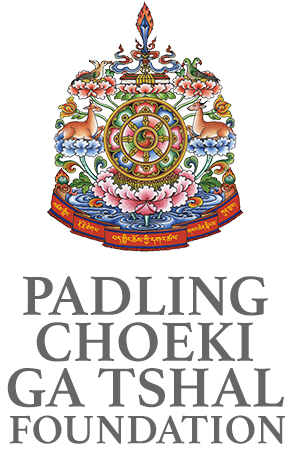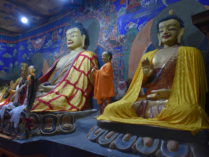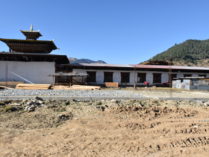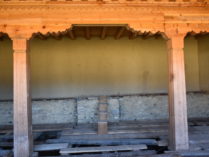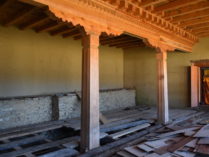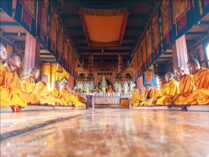Khewang Jangchub Chhoeling Temple, located in Phobjekha Gewog, Wangdue Phodrang District (Dzongkhag) is considered as one of the sacred religious site among many sacred places in Bhutan which was founded by Rigzin Pema Lingpa, a Great Treasure Discoverer who was among the Five Great Discoverers (Tertons) born towards the southern Himalayas.
The first foundation of the Temple
In the 14th century, incarnate (Trulku) Peljor Gyeltshen who was the heart son of the Kuenkhen Longchen Rabjam among his four true disciples volunteered to construct one hundred and thirteen religious monuments including temples, stupas and bridges in order to subdue the evil spirits and living demons causing serious threats to the spread of Buddhism. Amongst those, Khewang Jangchub Chhoeling temple was the main seat of subjugation of evil spirits and was considered the most sacred amongst all.
Outer Scenery of the Temple
Towards the peaceful southern land surrounded by the four precious jewels and in the place known as Phobjikha where all the wish-fulfilling things are gathered; and on the delightful open ground fenced by majestic nine mountain passes is where the sacred Kheywang Temple is located. Moreover landscape of Phobjekha is believed to be astrologically significant as well.
Sacred objects of the Temple
The main religious object of the temple is the statue of three Buddhas of past, present and future along with the statue of self-spoken Buddha Shakya Muni in the central and a treasure box of Trulku Peljor Gyelsthen, the founder of the temple. According to the Legend, about 400 years ago a boy named Dungshing Chugpai Drungdrung from Drongha village and a girl named Sangwa Kunley Yonten from Sangtana village fell in love towards each other during the religious festival of Gangteng Monastery. Both of them promised and made appointment to meet at Langle Pass (Langleyla). However, the girl failed to reach on time and meanwhile demoness who resided in that pass who was one of the seven siblings of Demoness named Nyala transformed herself to Sangwa Kinely Yonten and ate theheart of the boy after having physical intimacy with him. Upon arrival, she found her boyfriend death and she carried his corpse all the way to Khewang Jangchub Chhoeling Temple and presented on the rock lying in front of the temple. It was believed that it was when the girl prayed to the statue of Buddha that the statue spoke out saying the girl not to worry and she should go towards Gangteng to seek help. And the girl immediately left to Gangteng carrying the dead body leaving behind the imprint of the dead body on that rock which is still to be witnessed to this day.
The Establishment of the Buddhist College
In the earlier days, the temple was under the care of villagers. However, His Eminence Gangteng Incarnate (Trulku) Rinpoche in 2008 established a Primary Buddhist College (Zhirim Sheydra) with the appointment of Buddhist Teacher (Lopen) Kumbu Dorji of Gangteng Dongag Thoesam Rabgyaling College of Buddhist Studies as an Abbot (Lam) of the temple and renamed it as Kheywang Jangchub Choling. H.E initiated the establishment of the primary college at the temple to flourish the spread of Buddhism in the country and specifically to uphold and preserve the tradition of Pema Lingpa’s Doctrine of Concealed Treasures (Pedling Terchoe). The name of the temple as Kheywang was derived from khey (water) Wang (gulf) which meant ‘the temple built on top of the water pond” in the dialect of its locality. Since then many Buddhist Masters (Lopens) were appointed as teachers of Khewang Primary Buddhist College and today the college is under full administration of a Chief Abbot (Lama) along with two other Buddhist Masters (Lopens) teaching various ritual performances of Pema Ligpa’s Doctrine of Concealed Treasures (Pedling Terchoe) and other di erent Buddhist courses to the monks.
The extension and consecration ceremony of the temple
Though the ancient temple built by incarnate (Trulku) Peljor Gyeltshen was maintained as usual without distortion, the Ritual Performing Hall (Sungcho) was extended as the temple could not accommodate enough number of monks to perform the daily and other scheduled rituals of the college. At the same time, the monk’s residences were constructed to the right and left side of the temple. As per the oral story, it was said that after the completion of constructing the temple, Trulku Penjor Gyelshen envisioned the death of the statue sculptor Mahasiddha (Drupthob) for which the Trulku instructed the sculptor to rush the work of sculpturing the statues. Therefore, as a result of hurried work, the statues of the temple became distorted in its looks and shapes which are preserved as it is to this day. At the same time, it was believed that the statues remained in the state of profound divination when the sculptor passed away for which the eyes of the statues are di erent from each other unlike any other statues around the country. Other oral stories also say that during the consecration ceremony of the temple, the heart son (Thuksey) of Pema Lingpa, Dawa Gyeltshen was throwing the grains of blessing (Chagdu) in front of the Buddha’s statue when those grains fell directly between the eye brows of the statues and miraculously turned into the rosaryflowersbutdisappearedwhenthelaypeoplevisitedthestatueforo erings and prayers. It is also said that as a mark of the temple being consecrated by the Divine Madman (Drukpa Kunley), his footprint was left above the temple and is still to be seen.
Religious activities conducted in the Lhakhang
Continuing with the past trends, under patronage of the people of Sha Bjena and Gorphu village, following ritual events are observed annually in the Kheywang temple:
- Fasting Retreat (Nyungney) on 15th day of 4th lunar month coinciding with Lord Buddha’s Parinirvana of every year.
- Observation of Religious Festival of the Monkey Month (Trelda Tshechu) on 10th day of 5th lunar month of every year.
- Observation of first sermon of Lord Buddha on 4th day of 6th lunar month of every year.
- Fasting Retreat (Nyungney) on 7th lunar month of every year.
- Religious Festivals and Feast Offerings (Tshechu & Tshokhor)conducted on every 2nd and 7th Lunar Month of every year.
- Rituals of Vajrayana Guardian (Ngagsung) discovered by Kunkhyen Drime Woezer on every 2nd of 9th lunar month of every year.
- Celebration of Religious Festival of Kheywang Temple (Khewang Tshechu) on 3rd and 4th of 9th lunar month of every year.
- Observation of Descending day of Lord Buddha on 9th lunar month of every year.
The annual religious festival of the temple was stopped for some time because of the lack of mask dancers and spectators. However, when the people of that locality were residing at the place known as Bjena, they experienced severe wind and hailstorm and also there was increasing death of their domestic animals. Therefore, the people while requesting the Buddhist Abbots (Lamas) to perform the divination for those destructions in the village, the Abbots instructed the people to reinstitute the annual religious festival of Kheywang Temple to overcome such calamities. Thus, the annual religious festival of Kheywang Temple was resumed as an annual schedule to be conducted on the 11th lunar month of Buddhist calendar and it still continues undisrupted.
